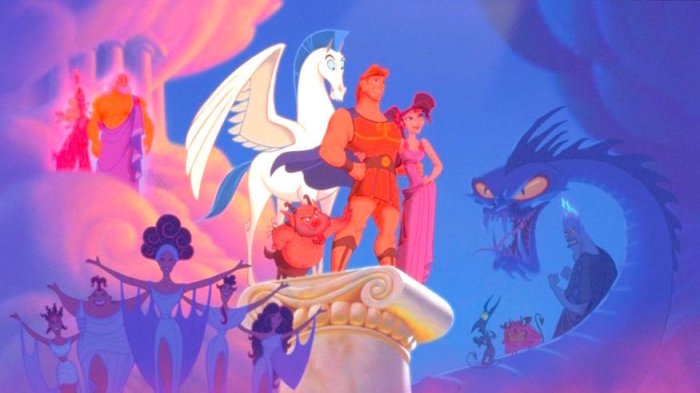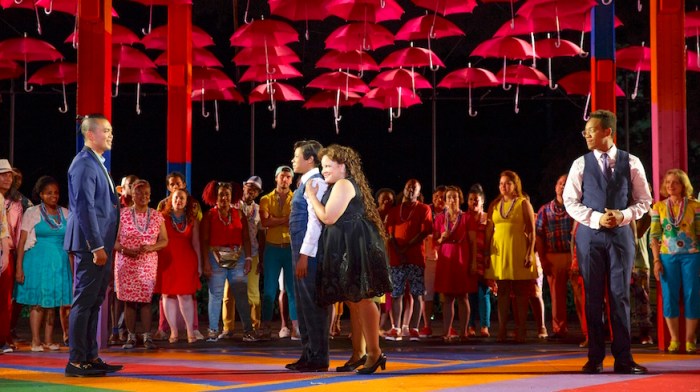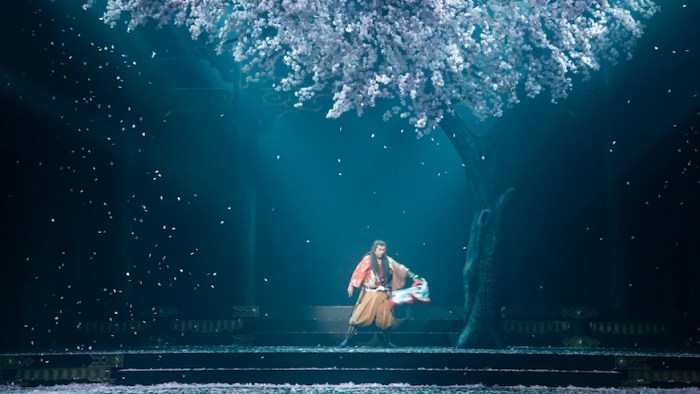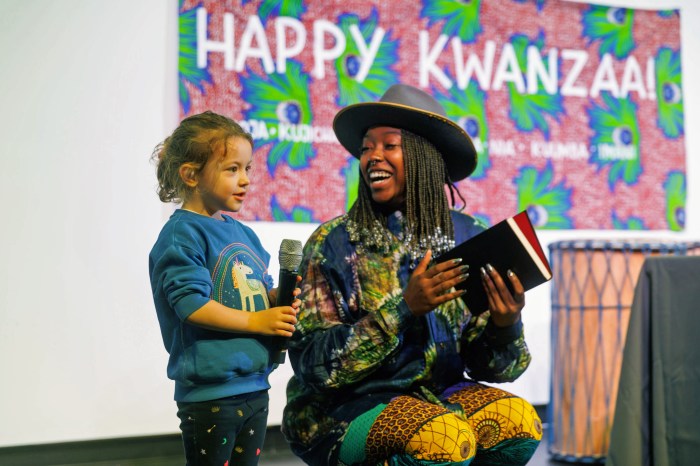Shakespeare in the Park is an essential New York City summer bucket list item for so many reasons. In the same city as the glittering theaters of Broadway, you can catch stars just as big and for free thanks to The Public Theater. Started in the summer of 1956, Shakespeare in the Park moved to its iconic home at the Delacorte Theater in 1972 with The Merchant of Venice starring James Earl Jones.
Set in the heart of Central Park, the Delacorte Theater is totally open to the elements, which creates its own magic — and sometimes interesting challenges for the cast. We’ve rounded up some of the wildest moments and true stories about what Shakespeare in the Park is really like told by its actors and crew, and why you won’t find any other theater experience like it in New York City.
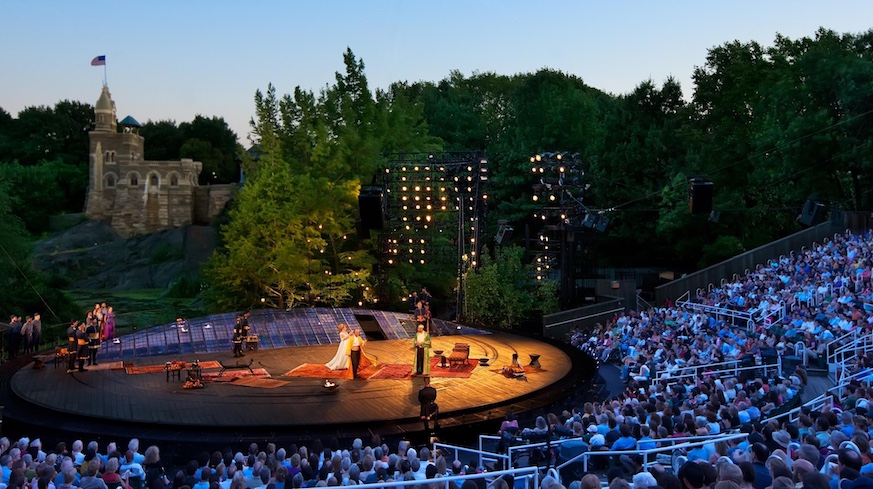
The show doesn’t stop for a little rain
Weather is a concern for any open-air theater production, but Shakespeare in the Park performances are never canceled before the 8 p.m. curtain, and only stopped if there’s danger like lightning or the rain is truly torrential. Which is what happened during 2007’s Romeo & Juliet, when the sky opened up just after Juliet drank her sleep potion.
“Outside, huddled six-deep under the theater’s awning and waiting to find out if we’d head back for the big finish, Allison Janney told us that when she’d done Taming of the Shrew in the park, the cast had prayed for rain because it was so hot,” New York Magazine reported. “Then Oskar Eustis, the Public’s creative director, made a decree: ‘God decided that tonight Romeo and Juliet will live!’ There would be no death-scene finale.”
Be prepared for the outdoors
Being outdoors can feel romantic — but you’d better be prepared for the realities of it, too. “It’s magical to see the stars and the moon when you’re talking about the stars and the moon,” Annaleigh Ashford told Newsday in 2017 while starring in A Midsummer Night’s Dream. “But I’m also grateful that we have good access to bug spray, sunscreen, umbrellas — we even have a slushy machine under the stage.” Take her advice and arrive prepared! (Though not the slushy machine part.)

Raccoons occasionally steal the show
For at least a decade, Shakespeare in the Park productions have had some unofficial cast members: a family of raccoons. One spooked Anne Hathaway and Audra McDonald during a scene in 2009’s Merchant of Venice, but during a performance of Othello earlier this summer, the cast merely paused after a raccoon hopped onstage, and when it exited the audience gave it a round of applause. There’s a whole family of them living beneath the stage, and by all accounts friendly enough — consider their cameos a fun interlude.
You’ve got to plan for interruptions
Because life in Central Park doesn’t stop when the curtain rises, there are contingency plans in place. “A big issue is helicopters,” Stephen Burdman, the artistic director of New York Classical Theater, told the New York Times in 2014. “We even have a helicopter cue — a physical cue so that actors can enter when they can’t hear the line. During As You Like It, Barack Obama flew over the Forest of Arden in Air Force One. It was very loud.”
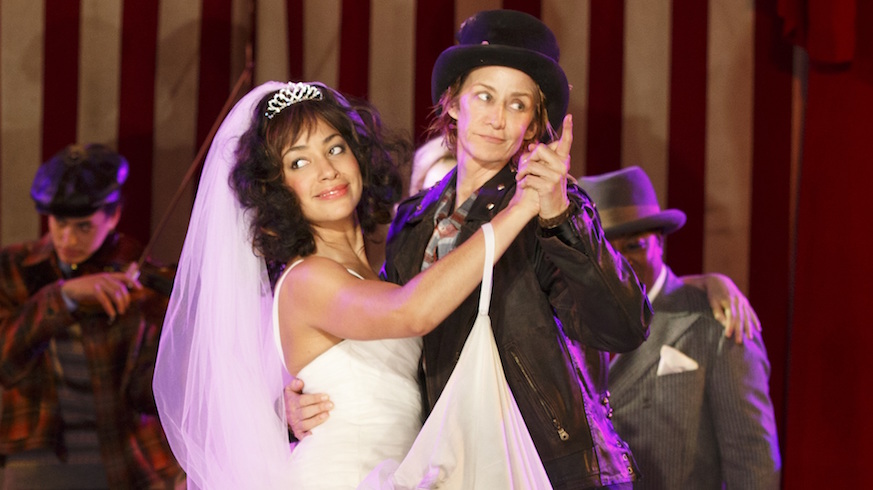
The lighting crew has an especially difficult task
“The lighting changes as the sun sets, so the tech process has to be very particular,” Donna Lynne Champlin, who co-starred in 2016’s all-female production of The Taming of the Shrew, told AMNY. Performances can require up to 1,400 lights and they must be coordinated each day as the sun sets a little bit later each night from May until the mid-June Summer Solstice, then a little bit earlier every night through August.
The audience sometimes becomes part of the production
There’s no barrier between the audience and the Delacorte Stage — if you wanted to, you could step right up and join the cast. Which is exactly what a young audience member did during The Winter’s Tale in 2014. “There was a moment in during the big festival sequence when we had 80 community members on stage, and there were probably 10 small children in the cast and they were all sitting together on a little circular platform,” director Lear deBessonet recalled to Town & Country magazine. “There was a moment when a 5-year-old girl in the audience ran — really, she sprinted — through the audience and joined the kids on stage. … What I love so much is that she did not see any separation between herself and the play. She didn’t see any reason that she shouldn’t be on that stage and part of that.”
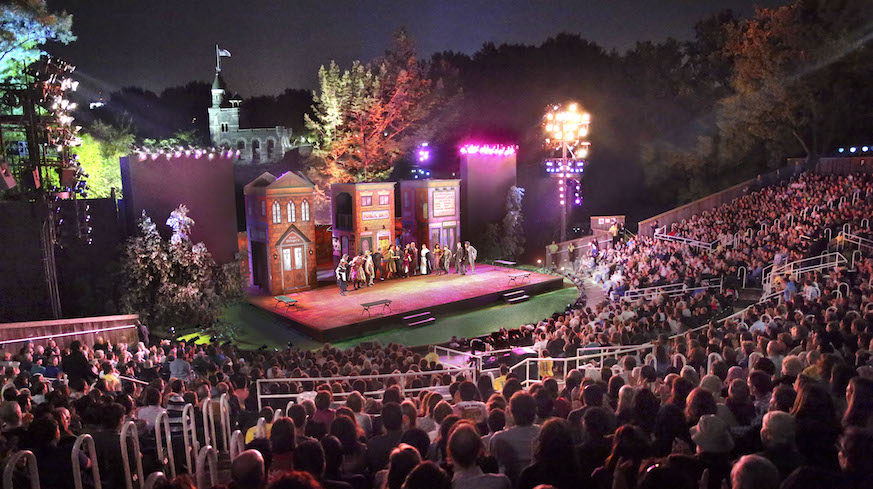
The setting turns Shakespeare in the Park into an immersive experience
The New York Times’ Julie Bloom reminisced about her annual pilgrimage to Shakespeare in the Park as a touchstone of her life in the city: “As you walk into the open amphitheater, an unburdening seems to happen: You leave the urban world behind and enter a more natural one. The Belvedere Castle appears cartoonlike in the background. From 7:30 to around 11 on any given night, a cycle of transformations takes place in the air, trees, sky and light. When the elements are all just right, a charge courses through the audience; the whole place breathes with life.”
Props don’t always work as intended
Audiences got some unexpected humor during the usually stoic drama Henry V in 1996, Kristine Nielsen recalls to TheaterMania: “[Elizabeth Marvel] was playing Katherine, the French princess, and I had to dress her onstage. The wind was awfully fierce that summer. I had her dress on a dummy and it kept rolling around with the wind. It was better comedy than I could ever come up with!”

Criticism can happen live
Because Shakespeare in the Park productions are free to attend and there is no barrier between the audience and the stage, it’s easy for people unhappy with the production to express their displeasure. During 2017’s Julius Caesar, which starred actors styled like the administration and family of President Donald Trump, a protester rushed the stage during Caesar’s murder, shouting that it was normalizing violence against right-wing politicians and their supporters. Ironically, the play actually makes an anti-violence point, as the death of Caesar eventually leads to the murders of his conspirators and the end of democracy in Rome for centuries. Do your homework before interrupting, please.

